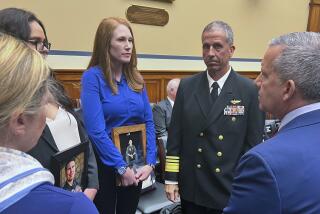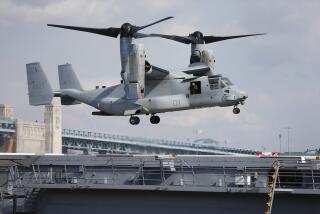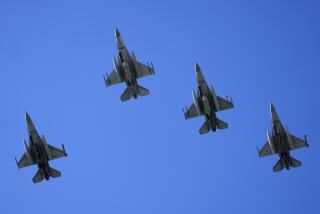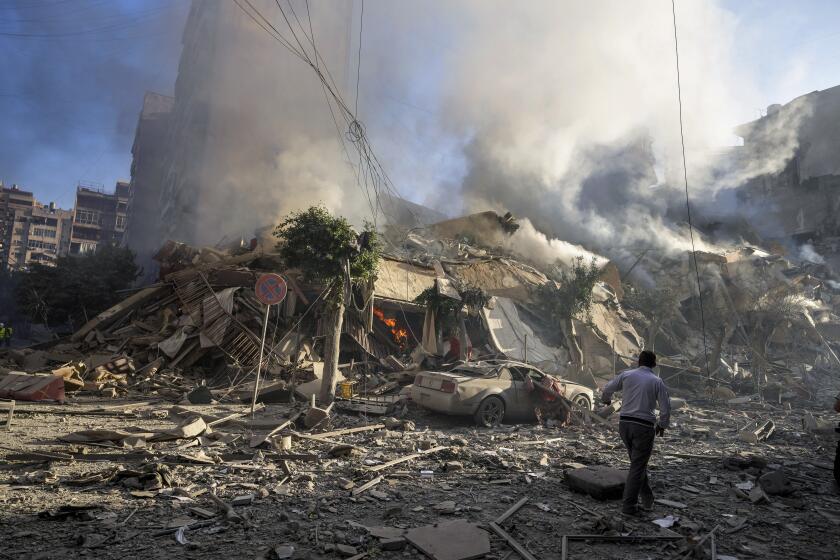Military Studies Cuts in Aircraft, Including B-2
WASHINGTON — Defense Secretary Dick Cheney has ordered an urgent review of the Pentagon’s four most expensive aircraft programs to determine whether they are justified in light of a changing global military environment and domestic budget constraints, senior defense officials said Tuesday.
Affected will be two huge Southern California aircraft projects now in production--the $70-billion B-2 Stealth bomber and the $37.5-billion C-17 transport--as well as advanced Air Force and Navy fighter planes still under development, partly in Southern California.
Cheney ordered the Joint Chiefs of Staff and senior deputies to challenge fundamental assumptions underlying the programs, which together will cost more than $200 billion. “The review should begin from basic principles,” Cheney wrote in a Dec. 19 memorandum ordering the study.
Similar studies are being started on other major weapons systems as well as the basic military doctrine underpinning the Pentagon’s $300-billion annual budget.
Cheney wants the reviews completed by March 30, shortly before he has to submit a new five-year defense spending plan to Congress.
The review will “cover everything from requirements to acquisition . . . including whether or not we have to buy” the weapons and what other programs would have to be sacrificed to pay for them, a senior defense official who requested anonymity said Tuesday.
“These are things that have been reviewed before, some of them many times, but this is a review in the context of a 1991 scenario . . . the changing world conditions, changing budget conditions. We’re having to prioritize more than we ever have before.”
The B-2, already under heavy fire in Congress as unneeded and unaffordable, could face production cuts or slowdowns. Despite his strong support for the program, Cheney has suggested that the Pentagon may not be able to afford all 132 of the new bombers the Air Force wants to buy.
The Northrop Corp.’s B-2 program employs 12,000 workers at plants in Palmdale and Pico Rivera.
The C-17 heavy transport plane, designed to lift a large number of troops, armor and artillery to Europe in the event of a major land war against the Warsaw Pact, is even more vulnerable to Pentagon budget-cutting. New intelligence estimates say that NATO would have at least five weeks’ warning of a Soviet attack on Europe, allowing U.S. reinforcement of Europe by existing transport planes or even ships.
Cheney already has slowed C-17 production in 1991 from 10 aircraft to six, Pentagon sources said.
The transport is in early production at Douglas Aircraft’s Long Beach plant, which employs about 8,000 workers on the project.
The aircraft study will also examine the Air Force’s proposed Advanced Tactical Fighter, estimated to cost $68 billion. It is to replace the F-15 and F-16 as the nation’s front-line air superiority fighter.
In addition, it will look at the Navy’s Advanced Tactical Aircraft, or A-12, a $35-billion carrier-based jet that is to replace the F-14 and F/A-18.
A team from Northrop Corp. and McDonnell Douglas Corp. is vying to win the Air Force tactical fighter contract against a team from Lockheed Corp., General Dynamics Corp. and Boeing Co. For the Navy’s tactical aircraft program, McDonnell Douglas has joined with General Dynamics; they have no present competition.
The Northrop and Lockheed work on the Air Force program is being done in the Los Angeles area.
The Cheney-ordered study is “pretty much a full-blown effort,” one senior Pentagon aide said. He suggested that the new Air Force and Navy fighters are vulnerable to cancellation, but purchases of the B-2 and C-17 are more likely to be reduced or postponed.
The Joint Chiefs of Staff is required to report on the military justification for the aircraft, including the planes’ proposed missions and whether existing airplanes can carry them out.
Paul D. Wolfowitz, undersecretary of defense for policy, has been ordered to review the policy implications of the four aircraft, including where the planes fit into overall U.S. defense and arms control strategy.
John A. Betti, undersecretary of defense for acquisition, will look at cost, number of aircraft to buy and potential alternatives.
The structure of the review indicates Cheney’s desire that it be dominated by senior civilians on his staff, officials said. The Joint Chiefs will deal strictly with the military requirements for the programs, and the uniformed services will provide data and advice to Cheney’s aides but will play no role in drawing conclusions, officials said.
A senior Air Force official downplayed the significance of the review, saying it was a “logical” step in times of tight budgets. He said he did not think that any of the Air Force programs were in danger of cancellation.
“It’s hard to envision an Air Force of the future without an air superiority fighter, a penetrating bomber or a new generation airlifter. So I think it’s more of a question of how many, or how soon, but not that you wouldn’t have force modernization,” said John J. Welch, Air Force assistant secretary for acquisition.
He conceded that the three Air Force planes “represent the big spenders” in that service’s budget and that it may not be able to afford all three if further budget cuts are decreed by the Administration or Congress.
The existence of the review was first disclosed on Monday by two defense trade papers, Aviation Week & Space Technology and Defense News.
More to Read
Sign up for Essential California
The most important California stories and recommendations in your inbox every morning.
You may occasionally receive promotional content from the Los Angeles Times.











